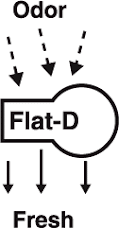We have many customers using our Flat-D Flatulence Deodorizer pads because of the gas that comes with their lactose intolerance. The inventor of the Flat-D is lactose intolerant. So he invented the Flatulence Deodorizer. Here is a nice all around article on the subject.
In reality, the prevalence of lactose intolerance in the U.S. is difficult to assess accurately. Still, it is likely much lower than suggested based upon self-report, according to the National Institutes of Health [1]. In part, this is because individuals have a tendency to misinterpret any gastrointestinal upset following a dairy-containing meal as evidence of lactose intolerance [2]. Most people, however — even those with lower-than-normal lactase levels — do not report gastrointestinal upset after being exposed to lactose in a blind challenge, explains the NIH.
Lactose intolerance results from insufficient production of the enzyme lactase (LCT), which the small intestine uses to help break down lactose, or milk sugar. Lactose is a disaccharide, meaning it’s made up of two smaller sugar units called monosaccharides. The small intestine can absorb monosaccharides, but disaccharides (and larger combinations of monosaccharides, called polysaccharides) have to be digested into their monosaccharide building blocks before they can be absorbed. The digestive tract uses a wide variety of enzymes to accomplish this task. Digestive enzymes are very specific in their function; the enzyme responsible for breaking down lactose, for instance, can’t digest sucrose (table sugar). Sucrase, the enzyme that breaks down sucrose, is similarly incapable of digesting lactose. As such, a person must produce lactase in order to digest lactose.
In those individuals with true lactose intolerance, the absence of appropriate quantities of lactase means that lactose passes undigested into the large intestine. There, native flora (naturally-occurring bacterial species) of the gut break down the lactose to provide for their own energy needs. This results in the accumulation of a large amount of gas, which is a waste product of bacterial lactose digestion. The gas leads to the sensations of bloating and cramping, and can result in flatulence. Undigested lactose in the large intestine can also cause diarrhea.
Most people make lactase in appropriate amounts early in life; without lactase, babies would be incapable of digesting breast milk (which is actually higher in lactose than cow’s milk). Some ethnic groups produce less lactase after the age of weaning, leading to lactose intolerance that begins in childhood. This lactose intolerance persists throughout adulthood, and is most common in individuals of African, Hispanic (non-European), Native American, and Asian descent. Europeans are much less likely to develop lactose intolerance post-babyhood. Further, there’s some evidence to suggest that lactose intolerance increases with advancing age [3], though there isn’t a significant body of data supporting this.
Friday, February 17, 2012
Subscribe to:
Posts (Atom)
